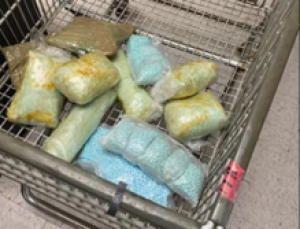In a recent incident, El Centro Sector Border Patrol agents in Indio, California, foiled a fentanyl smuggling operation. The incident occurred on a Saturday morning when a red sedan approached the U.S. Border Patrol’s Highway 86 immigration checkpoint. The vehicle contained a driver and one passenger, an 18-year-old U.S. citizen woman.
During a routine inspection, a K-9 unit alerted to the trunk of the vehicle, indicating the presence of something suspicious. As a result, the driver and passenger were directed to a secondary inspection area for further examination. It was revealed that the driver was an employed rideshare driver and was providing transportation services for the passenger.
Once in the secondary inspection area, the K-9 unit again alerted to the trunk area. Border Patrol agents conducted a thorough examination and discovered 11 clear plastic bags, each containing blue pills. The pills were tested and confirmed to be fentanyl, a highly dangerous synthetic opioid. The plastic bags were found inside larger travel bags suspected to belong to the passenger.
The passenger, along with the seized fentanyl, was immediately handed over to the Drug Enforcement Administration (DEA) for further processing and investigation. The total weight of the fentanyl seized in this operation was 14.54 pounds, with an estimated street value of $164,750. This successful interception prevented a significant amount of fentanyl from reaching the streets and potentially causing harm to individuals.
Fentanyl, a potent opioid that is 50-100 times stronger than morphine, has been responsible for a significant increase in overdose deaths in recent years. Its illicit distribution and use have become a major concern for law enforcement agencies. It is a highly addictive substance that can have deadly consequences even at minimal doses.
The collaboration between the U.S. Border Patrol and other law enforcement agencies, such as the DEA, is crucial in combating the illegal drug trade. This incident highlights the dedication and effectiveness of these agencies in detecting and intercepting attempts to smuggle dangerous substances like fentanyl across the border.
The use of rideshare services in smuggling operations is a concerning development. Criminals are increasingly using legal means to hide their illegal activities. Rideshare drivers, who may unknowingly be involved in smuggling operations, must remain vigilant and report any suspicious activities to law enforcement authorities.
Efforts to prevent the smuggling of drugs like fentanyl require a multi-pronged approach. This includes strengthening border security, enhancing detection capabilities, and improving intelligence sharing among agencies. Additionally, raising public awareness about the dangers of fentanyl and the importance of reporting suspicious activities can help in identifying and disrupting smuggling networks.
Law enforcement agencies are also focusing on dismantling the source of fentanyl production, which is predominantly based in China and illicitly trafficked into the United States. International cooperation and diplomatic efforts are essential in addressing this global issue and reducing the availability of fentanyl in the illicit market.
Moreover, combating the opioid crisis caused by fentanyl requires a comprehensive approach that includes prevention, treatment, and recovery programs. Efforts should be directed towards educating the public about the risks associated with opioid use, implementing accessible addiction treatment programs, and supporting individuals in their recovery journey.
In conclusion, the foiled fentanyl smuggling operation in Indio, California, is a testament to the effectiveness of law enforcement agencies in intercepting dangerous drugs before they reach the streets. The collaboration between the U.S. Border Patrol and the DEA is crucial in combating the illicit drug trade and protecting public health. Efforts must continue to strengthen border security, enhance detection capabilities, and raise public awareness to prevent the smuggling of fentanyl and other illicit substances. Additionally, addressing the opioid crisis requires a holistic approach that focuses on prevention, treatment, and recovery.










